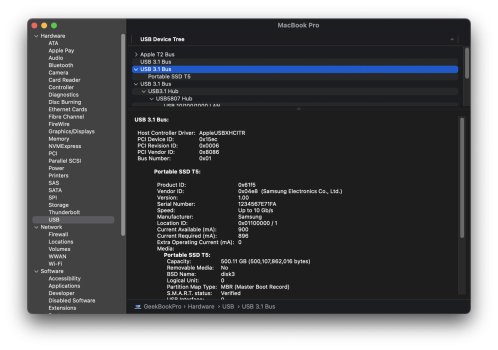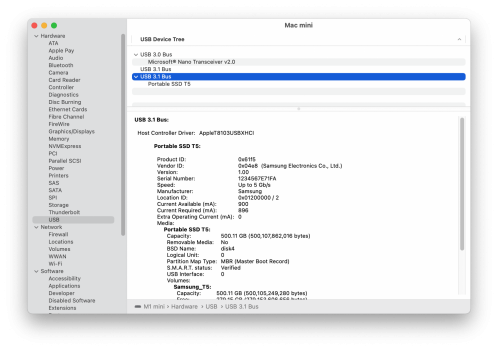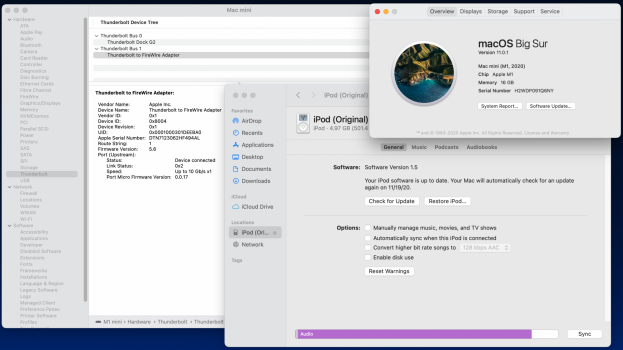After quite a bit of testing, I have concluded that the USB bus on at least my Mac mini M1 does not actually support "USB 3.1 Gen 2 (up to 10Gb/s)" as listed on the Tech Specs page.
I have a Samsung T5 USB-C SSD. It supports "USB 3.1 Gen 2 10Gb/s" (Gawd, I hate USB 3.1+ naming conventions...†)
When I plug it directly to one of my 16" MacBook Pro's ports via USB-C-to-USB-C cable, it connects at 10 Gb/s

When I connect it to my new M1 mini, on the other hand.... If I go through my Thunderbolt 3 Dock, it connects at the full 10 Gb/s:

But if I connect directly to the other Thunderbolt 3/USB-C port, it only connects at 5 Gb/s, yes, using the same USB-C-to-USB-C cable as both previous connections:

If I unplug the TB3 Dock (who knows, maybe it's "using up the bandwidth" and forcing the USB controller to drop speeds?) and have the SSD as the only thing plugged in to either TB3 port, still only 5 Gb/s:

The Thunderbolt 3 Dock does connect at its proper 40 Gb/s Thunderbolt speed, though. But if you were hoping for 10 Gb/s via USB 3.1 Gen 2... Forget about it.
† For full confusion, the USB Implementers Forum has completely screwed up all naming conventions as it comes to USB after USB 3.0 came out. 5 Gb/s is variously called "USB 3.0 SuperSpeed", "USB 3.1 Gen 1", and "USB 3.2 Gen 1". 10 Gb/s is variously called "USB 3.1 Gen 2" and "USB 3.2 Gen 2". The latest standard, 20 Gb/s, is "USB 3.2 Gen 2x2". And with USB4 (yes, just "USB4", not "USB 4.0"...) they keep all the old names for those old speeds - BUT - USB4 also adds "USB4 Gen 2x2" as another 20 Gb/s protocol (technically different electrically, even though it's the same speed!) and "USB4 Gen 3x2" for the new 40 Gb/s speed. And this is why Apple shouldn't be allowed to advertise the new M1 Macs as "USB 4" - because USB4 requires support for both the 10 Gb/s speed and the 20 Gb/s speed. Apple doesn't even claim the 20 Gb/s speed, only the 10 Gb/s, which doesn't work for me. USB4 also has Thunderbolt 3 support as optional, which Apple does at least have. But they should be calling the ports "Thunderbolt 3 / USB 3 5 Gb/s", not "USB4 / Thunderbolt 3"
I have a Samsung T5 USB-C SSD. It supports "USB 3.1 Gen 2 10Gb/s" (Gawd, I hate USB 3.1+ naming conventions...†)
When I plug it directly to one of my 16" MacBook Pro's ports via USB-C-to-USB-C cable, it connects at 10 Gb/s

When I connect it to my new M1 mini, on the other hand.... If I go through my Thunderbolt 3 Dock, it connects at the full 10 Gb/s:

But if I connect directly to the other Thunderbolt 3/USB-C port, it only connects at 5 Gb/s, yes, using the same USB-C-to-USB-C cable as both previous connections:

If I unplug the TB3 Dock (who knows, maybe it's "using up the bandwidth" and forcing the USB controller to drop speeds?) and have the SSD as the only thing plugged in to either TB3 port, still only 5 Gb/s:

The Thunderbolt 3 Dock does connect at its proper 40 Gb/s Thunderbolt speed, though. But if you were hoping for 10 Gb/s via USB 3.1 Gen 2... Forget about it.
† For full confusion, the USB Implementers Forum has completely screwed up all naming conventions as it comes to USB after USB 3.0 came out. 5 Gb/s is variously called "USB 3.0 SuperSpeed", "USB 3.1 Gen 1", and "USB 3.2 Gen 1". 10 Gb/s is variously called "USB 3.1 Gen 2" and "USB 3.2 Gen 2". The latest standard, 20 Gb/s, is "USB 3.2 Gen 2x2". And with USB4 (yes, just "USB4", not "USB 4.0"...) they keep all the old names for those old speeds - BUT - USB4 also adds "USB4 Gen 2x2" as another 20 Gb/s protocol (technically different electrically, even though it's the same speed!) and "USB4 Gen 3x2" for the new 40 Gb/s speed. And this is why Apple shouldn't be allowed to advertise the new M1 Macs as "USB 4" - because USB4 requires support for both the 10 Gb/s speed and the 20 Gb/s speed. Apple doesn't even claim the 20 Gb/s speed, only the 10 Gb/s, which doesn't work for me. USB4 also has Thunderbolt 3 support as optional, which Apple does at least have. But they should be calling the ports "Thunderbolt 3 / USB 3 5 Gb/s", not "USB4 / Thunderbolt 3"


